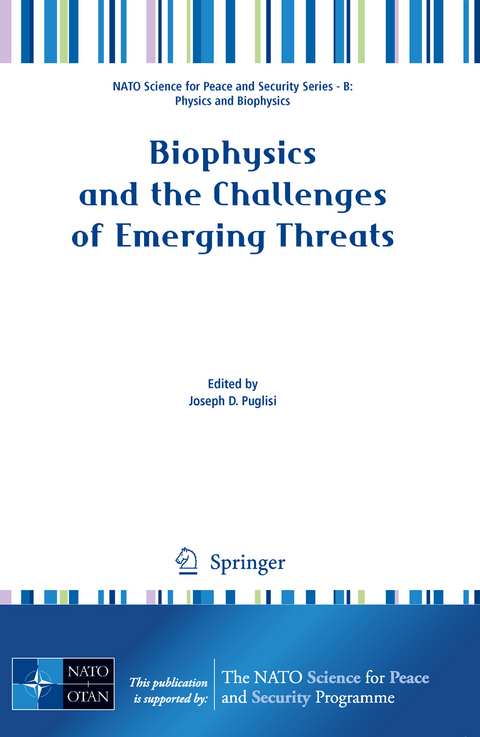
Biophysics and the Challenges of Emerging Threats
Seiten
2009
Springer (Verlag)
978-90-481-2367-4 (ISBN)
Springer (Verlag)
978-90-481-2367-4 (ISBN)
Triplet O efficiently 2 2 quenches dye triplet states responsible for blinking. Singlet O reacts efficiently with organic dyes, 2 amino acids, and nucleobases [19, 20]. In the presence of saturating dissolved O , blinking of fluorescent dyes is sup- 2 pressed, but oxidative damage to dyes and biomolecules is rapid.
Single-molecule techniques eliminate ensemble averaging, thus revealing transient or rare species in heterogeneous systems [1–3]. These approaches have been employed to probe myriad biological phenomena, including protein and RNA folding [4–6], enzyme kinetics [7, 8], and even protein biosynthesis [1, 9, 10]. In particular, immobilization-based fluorescence te- niques such as total internal reflection fluorescence microscopy (TIRF-M) have recently allowed for the observation of multiple events on the millis- onds to seconds timescale [11–13]. Single-molecule fluorescence methods are challenged by the instability of single fluorophores. The organic fluorophores commonly employed in single-molecule studies of biological systems display fast photobleaching, intensity fluctuations on the millisecond timescale (blinking), or both. These phenomena limit observation time and complicate the interpretation of fl- rescence fluctuations [14, 15]. Molecular oxygen (O) modulates dye stability. Triplet O efficiently 2 2 quenches dye triplet states responsible for blinking. This results in the for- tion of singlet oxygen [16–18]. Singlet O reacts efficiently with organic dyes, 2 amino acids, and nucleobases [19, 20]. Oxidized dyes are no longer fluor- cent; oxidative damage impairs the folding and function of biomolecules. In the presence of saturating dissolved O , blinking of fluorescent dyes is sup- 2 pressed, but oxidative damage to dyes and biomolecules is rapid. Enzymatic O -scavenging systems are commonly employed to ameliorate dye instability. 2 Small molecules are often employed to suppress blinking at low O levels.
Single-molecule techniques eliminate ensemble averaging, thus revealing transient or rare species in heterogeneous systems [1–3]. These approaches have been employed to probe myriad biological phenomena, including protein and RNA folding [4–6], enzyme kinetics [7, 8], and even protein biosynthesis [1, 9, 10]. In particular, immobilization-based fluorescence te- niques such as total internal reflection fluorescence microscopy (TIRF-M) have recently allowed for the observation of multiple events on the millis- onds to seconds timescale [11–13]. Single-molecule fluorescence methods are challenged by the instability of single fluorophores. The organic fluorophores commonly employed in single-molecule studies of biological systems display fast photobleaching, intensity fluctuations on the millisecond timescale (blinking), or both. These phenomena limit observation time and complicate the interpretation of fl- rescence fluctuations [14, 15]. Molecular oxygen (O) modulates dye stability. Triplet O efficiently 2 2 quenches dye triplet states responsible for blinking. This results in the for- tion of singlet oxygen [16–18]. Singlet O reacts efficiently with organic dyes, 2 amino acids, and nucleobases [19, 20]. Oxidized dyes are no longer fluor- cent; oxidative damage impairs the folding and function of biomolecules. In the presence of saturating dissolved O , blinking of fluorescent dyes is sup- 2 pressed, but oxidative damage to dyes and biomolecules is rapid. Enzymatic O -scavenging systems are commonly employed to ameliorate dye instability. 2 Small molecules are often employed to suppress blinking at low O levels.
A Simple Model for Protein Folding.- Complementarity of Hydrophobic/Hydrophilic Properties In Protein—Ligand Complexes: A New Tool to Improve Docking Results.- Structures of Cvnh Family Lectins.- Biophysical Approaches To Study Dna Base Flipping.- The Diversity of Nuclear Magnetic Resonance Spectroscopy.- Improved Dye Stability in Single-Molecule Fluorescence Experiments.- The Evaluation of Isotope Editing and Filtering for Protein—Ligand Interaction Elucidation by Nmr.- Ribosome: an Ancient Cellular Nano-Machine for Genetic Code Translation.
| Reihe/Serie | NATO Science for Peace and Security Series |
|---|---|
| Zusatzinfo | VII, 179 p. |
| Verlagsort | Dordrecht |
| Sprache | englisch |
| Maße | 155 x 235 mm |
| Themenwelt | Naturwissenschaften ► Biologie ► Biochemie |
| Naturwissenschaften ► Physik / Astronomie ► Angewandte Physik | |
| Technik ► Umwelttechnik / Biotechnologie | |
| ISBN-10 | 90-481-2367-4 / 9048123674 |
| ISBN-13 | 978-90-481-2367-4 / 9789048123674 |
| Zustand | Neuware |
| Haben Sie eine Frage zum Produkt? |
Mehr entdecken
aus dem Bereich
aus dem Bereich
die Biochemie und industrielle Nutzung von Naturstoffen
Buch | Softcover (2024)
Springer Fachmedien (Verlag)
CHF 69,95
von Grund auf verständlich erklärt
Buch | Softcover (2022)
Springer Spektrum (Verlag)
CHF 48,95


